Take A Moment, Look Outside Your Window. 🌷🌼
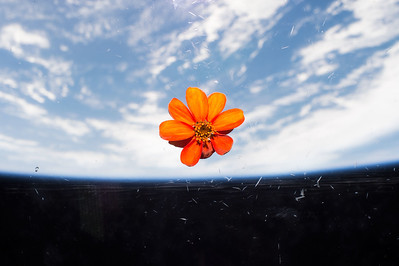
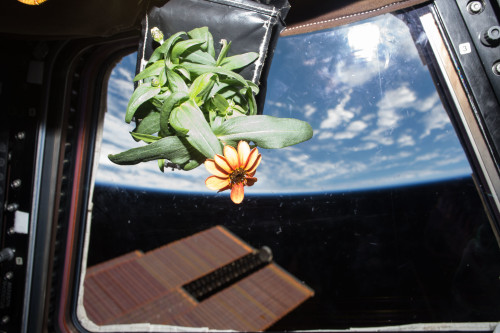

Take a moment, look outside your window. 🌷🌼
Today is the #FirstDayOfSpring in the Northern Hemisphere, also known as the vernal equinox.
#DYK Earth’s tilted axis causes the season? Throughout the year, different parts of Earth receive the Sun’s most direct rays. So, when the North Pole tilts toward the Sun, it’s summer in the Northern Hemisphere. And when the South Pole tilts toward the Sun, it’s winter in the Northern Hemisphere.
These images are of Zinnias. They are part of the flowering crop experiment that began aboard the International Space Station on Nov. 16, 2015, when NASA astronaut Kjell Lindgren activated the Veggie system and its rooting "pillows" containing zinnia seeds.
Make sure to follow us on Tumblr for your regular dose of space: http://nasa.tumblr.com.
More Posts from Nasa and Others
A Spacecraft's Second Life: Our K2 mission
A critical failure that ended one mission has borne an unexpected and an exciting new science opportunity. The Kepler spacecraft, known for finding thousands of planets orbiting other stars, has a new job as the K2 mission.
Like its predecessor, K2 detects the tiny, telltale dips in the brightness of a star as an object passes or transits it, to possibly reveal the presence of a planet. Searching close neighboring stars for near-Earth-sized planets, K2 is finding planets ripe for follow-up studies on their atmospheres and to see what the planet is made of. A step up from its predecessor, K2 is revealing new info on comets, asteroids, dwarf planets, ice giants and moons. It will also provide new insight into areas as diverse as the birth of new stars, how stars explode into spectacular supernovae, and even the evolution of black holes.
K2 is expanding the planet-hunting legacy and has ushered in entirely new opportunities in astrophysics research, yet this is only the beginning.
Searching Nearby for Signs of Life

Image credit: ESO/L. Calçada
Scientists are excited about nearby multi-planet system known as K2-3. This planetary system, discovered by K2, is made of three super-Earth-sized planets orbiting a cool M-star (or red dwarf) 135 light-years away, which is relatively close in astronomical terms. To put that distance into perspective, if the Milky Way galaxy was scaled down to the size of the continental U.S. it would be the equivalent of walking the three-mile long Golden Gate Park in San Francisco, California. At this distance, our other powerful space-investigators – the Hubble Space Telescope and the forthcoming James Webb Space Telescope (JWST) – could study the atmospheres of these worlds in search of chemical fingerprints that could be indicative of life. K2 expects to find a few hundred of these close-by, near-Earth-sized neighbors.
K2 won’t be alone in searching for nearby planets outside our solar system. Revving up for launch around 2017-2018, our Transiting Exoplanet Survey Satellite (TESS) plans to monitor 200,000 close stars for planets, with a focus on finding Earth and Super-Earth-sized planets.
The above image is an artist rendering of Gliese 581, a planetary system representative of K2-3.
Neptune's Moon Dance
Movie credit: NASA Ames/SETI Institute/J. Rowe
Spying on our neighbors in our own solar system, K2 caught Neptune in a dance with its moons Triton and Nereid. On day 15 (day counter located in the top right-hand corner of the green frame) of the sped-up movie, Neptune appears, followed by its moon Triton, which looks small and faint. Keen-eyed observers can also spot Neptune's tiny moon Nereid at day 24. Neptune is not moving backward but appears to do so because of the changing position of the Kepler spacecraft as it orbits around the sun. A few fast-moving asteroids make cameo appearances in the movie, showing up as streaks across the K2 field of view. The red dots are a few of the stars K2 examines in its search for transiting planets outside of our solar system. An international team of astronomers is using these data to track Neptune’s weather and probe the planet’s internal structure by studying subtle brightness fluctuations that can only be observed with K2.
Dead Star Devours Planet

Image credit: CfA/Mark A. Garlick
K2 also caught a white dwarf – the dead core of an exploded star –vaporizing a nearby tiny rocky planet. Slowly the planet will disintegrate, leaving a dusting of metals on the surface of the star. This trail of debris blocks a tiny fraction of starlight from the vantage point of the spacecraft producing an unusual, but vaguely familiar pattern in the data. Recognizing the pattern, scientists further investigated the dwarf’s atmosphere to confirm their find. This discovery has helped validate a long-held theory that white dwarfs are capable of cannibalizing possible remnant planets that have survived within its solar system.
Searching for Far Out Worlds

NASA/JPL-Caltech
In April, spaced-based K2 and ground-based observatories on five continents will participate in a global experiment in exoplanet observation and simultaneously monitor the same region of sky towards the center of our galaxy to search for small planets, such as the size of Earth, orbiting very far from their host star or, in some cases, orbiting no star at all. For this experiment, scientists will use gravitational microlensing – the phenomenon that occurs when the gravity of a foreground object focuses and magnifies the light from a distant background star.
The animation demonstrates the principles of microlensing. The observer on Earth sees the source (distant) star when the lens (closer) star and planet pass through the center of the image. The inset shows what may be seen through a ground-based telescope. The image brightens twice, indicating when the star and planet pass through the observatory's line of sight to the distant star.
Full microlensing animation available HERE.
Make sure to follow us on Tumblr for your regular dose of space: http://nasa.tumblr.com
Special Celestial Events in June 2020
Earth and the Moon are in a constant dance as they orbit the Sun — and in June 2020, they’ll create two special celestial events.
June 20: Summer solstice in the Northern Hemisphere
Earth has a slight tilt as it orbits the Sun, and June is one of two times each year when that tilt is most prominent: a solstice. At the solstices, which happen each year in June and December, Earth’s tilt is at the greatest angle with respect to the plane of its orbit, meaning that one hemisphere is tilted towards the Sun, and the other hemisphere is tilted away.

In the Northern Hemisphere, June 20 is the summer solstice — the Northern Hemisphere is tilted towards the Sun, so the June solstice is the day on which the Northern Hemisphere receives the longest stretch of daylight for the year.
In both hemispheres, the Sun will rise and set at its northernmost point on the horizon. After June 20, the Sun will appear to travel south.

This view from our Earth Polychromatic Imaging Camera on the National Oceanic and Atmospheric Administration's DSCOVR satellite shows the change in Earth’s tilt between the June and December solstices.
During the June solstice, the Southern Hemisphere is tilted away from the Sun, meaning the June solstice marks its shortest stretch of daylight for the year. June is the Southern Hemisphere’s winter solstice.
June 21: Annular solar eclipse in Africa and Asia
The day after the solstice will see another special celestial event: an annular eclipse. Eclipses happen when the Moon lines up just right between the Sun and Earth, allowing it to block out part or all of the Sun’s bright face and cast a shadow on Earth. Though the Moon orbits Earth about once a month, its orbit is tilted by five degrees, so the perfect alignment that creates an eclipse is relatively rare. Often the Moon is too high or low in our sky to block out the Sun.

The June 21, 2020, eclipse is an annular eclipse visible primarily in Africa and Asia. During an annular eclipse, the Moon is too far from Earth and its apparent size is too small to entirely block out the face of the Sun, leaving a sliver of the Sun visible around the Moon’s edge during the eclipse and creating a “ring of fire” effect.

Credit: Dale Cruikshank
Outside the path of annularity, people in other parts of Africa, Asia and even some of Europe and the Pacific have a chance to see a partial solar eclipse, weather permitting. The degree of the partial eclipse depends on how close you are to the path of annularity. Locations far from the path of annularity will see only a small part of the Sun covered by the Moon, while places close to the path will see almost all of the Sun obscured.

No matter where you are, you must take safety precautions to watch the eclipse safely. There is no part of an annular eclipse during which it is safe to look directly at the Sun. You must use a proper solar filter or an indirect viewing method during all phases of the eclipse — even if only a tiny sliver of the Sun is visible around the Moon’s edge, that’s still enough to cause damage to your eyes.
Make sure to follow us on Tumblr for your regular dose of space: http://nasa.tumblr.com
Gamma-ray Bursts: Black Hole Birth Announcements
Gamma-ray bursts are the brightest, most violent explosions in the universe, but they can be surprisingly tricky to detect. Our eyes can't see them because they are tuned to just a limited portion of the types of light that exist, but thanks to technology, we can even see the highest-energy form of light in the cosmos — gamma rays.
So how did we discover gamma-ray bursts?
Accidentally!

We didn’t actually develop gamma-ray detectors to peer at the universe — we were keeping an eye on our neighbors! During the Cold War, the United States and the former Soviet Union both signed the Nuclear Test Ban Treaty of 1963 that stated neither nation would test nuclear weapons in space. Just one week later, the US launched the first Vela satellite to ensure the treaty wasn’t being violated. What they saw instead were gamma-ray events happening out in the cosmos!

Things Going Bump in the Cosmos
Each of these gamma-ray events, dubbed “gamma-ray bursts” or GRBs, lasted such a short time that information was very difficult to gather. For decades their origins, locations and causes remained a cosmic mystery, but in recent years we’ve been able to figure out a lot about GRBs. They come in two flavors: short-duration (less than two seconds) and long-duration (two seconds or more). Short and long bursts seem to be caused by different cosmic events, but the end result is thought to be the birth of a black hole.

Short GRBs are created by binary neutron star mergers. Neutron stars are the superdense leftover cores of really massive stars that have gone supernova. When two of them crash together (long after they’ve gone supernova) the collision releases a spectacular amount of energy before producing a black hole. Astronomers suspect something similar may occur in a merger between a neutron star and an already-existing black hole.

Long GRBs account for most of the bursts we see and can be created when an extremely massive star goes supernova and launches jets of material at nearly the speed of light (though not every supernova will produce a GRB). They can last just a few seconds or several minutes, though some extremely long GRBs have been known to last for hours!

A Gamma-Ray Burst a Day Sends Waves of Light Our Way!
Our Fermi Gamma-ray Space Telescope detects a GRB nearly every day, but there are actually many more happening — we just can’t see them! In a GRB, the gamma rays are shot out in a narrow beam. We have to be lined up just right in order to detect them, because not all bursts are beamed toward us — when we see one it's because we're looking right down the barrel of the gamma-ray gun. Scientists estimate that there are at least 50 times more GRBs happening each day than we detect!

So what’s left after a GRB — just a solitary black hole? Since GRBs usually last only a matter of seconds, it’s very difficult to study them in-depth. Fortunately, each one leaves an afterglow that can last for hours or even years in extreme cases. Afterglows are created when the GRB jets run into material surrounding the star. Because that material slows the jets down, we see lower-energy light, like X-rays and radio waves, that can take a while to fade. Afterglows are so important in helping us understand more about GRBs that our Neil Gehrels Swift Observatory was specifically designed to study them!

Last fall, we had the opportunity to learn even more from a gamma-ray burst than usual! From 130 million light-years away, Fermi witnessed a pair of neutron stars collide, creating a spectacular short GRB. What made this burst extra special was the fact that ground-based gravitational wave detectors LIGO and Virgo caught the same event, linking light and gravitational waves to the same source for the first time ever!

For over 10 years now, Fermi has been exploring the gamma-ray universe. Thanks to Fermi, scientists are learning more about the fundamental physics of the cosmos, from dark matter to the nature of space-time and beyond. Discover more about how we’ll be celebrating Fermi’s achievements all year!
Make sure to follow us on Tumblr for your regular dose of space: http://nasa.tumblr.com
NASA and Star Trek
Star Trek debuted in September 1966 and in its various incarnations, the series has been an inspiration to many, even some of us at NASA. The series allowed its fans to explore “strange new worlds” and to dream of what could be right in their living rooms. To celebrate the show’s 50th anniversary, we’ve collected some Trek-themed photos featuring Star Trek cast members and NASA astronauts.
Serious Business

The STS-54 crew of the space shuttle Endeavour in their official "gag" photo are costumed as the bridge crew of the Enterprise as depicted in the movie "Star Trek II: The Wrath of Khan.” The photo was taken on the Star Trek Adventure set of the Universal Studios California theme park in Los Angeles, California, while the crew was on a west coast training and public relations tour during the Summer of 1992. From left to right:
Greg Harbaugh (Mission Specialist/Engineering Officer)
Mario "Spock" Runco Jr. (Mission Specialist/1st Officer/Science Officer)
John Casper (Commander/Captain)
Susan Helms (Mission Specialist/Communications Officer)
Don McMonagle (Pilot/Navigation-Helm Officer)
“I have been, and always shall be, your friend”

Astronaut John Creighton shows the on board Graphical Retrieval Information Display (GRID) computer, which displays a likeness of Mr. Spock aboard STS-051G, June 18, 1985.
“A Keyboard. . . How Quaint”

Actor James Doohan (who played engineering genius Montgomery Scott in Star Trek) sits in the commanders seat of the Full Fuselage Trainer while astronaut Mario Runco explains the control panel during a tour of Johnson Space Center on Jan. 18, 1991.
“You Wanted Excitement, How's Your Adrenaline?”

Actress Nichelle Nichols (Uhura in Star Trek) toured Johnson Space Center in Houston on March 4, 1977, while Apollo 12 lunar module pilot and Skylab II commander Alan Bean showed her what it felt like inside the Lower Body Negative Pressure Device and showed her how the Shuttle Procedures Simulator operated.


Nichols paid us another visit in 2012 and 2015 with the Space Traveling Museum.
Infinite Diversity, Infinite Combinations

European Space Agency astronaut Samantha Cristoforetti gave the Vulcan salute aboard the International Space Station shortly after the passing of Leonard Nimoy on Feb. 28, 2015. She commented on Tweeter: " ‘Of all the souls I have encountered.. his was the most human.’ Thx @TheRealNimoy for bringing Spock to life for us"
Live Long And Prosper

While visiting Johnson Space Center in Houston, TX, George Takei (Hikaru Sulu on the original series) had the chance to exchange Vulcan salutes with Robonaut on May 29, 2012.
“Let’s See What’s Out There”

Scott Bakula, who played Captain Jonathan Archer on Star Trek: Enterprise, stands with astronauts Terry Virts and Mike Fincke on set. The two astronauts made guest appearances on the series finale episode “These Are The Voyages . . .” March 2005.
Boldly Going For Real

Above is the crew of STS-134, the next to last shuttle mission, in their version of the 2009 Star Trek movie poster.

The crew of Expedition 21 aboard the International Space Station also made a Trek-themed poster in 2009, wearing uniforms from Star Trek: The Next Generation with the Enterprise NX-01 silhouette in the background.
Learn more about Star Trek and NASA.
Make sure to follow us on Tumblr for your regular dose of space: http://nasa.tumblr.com
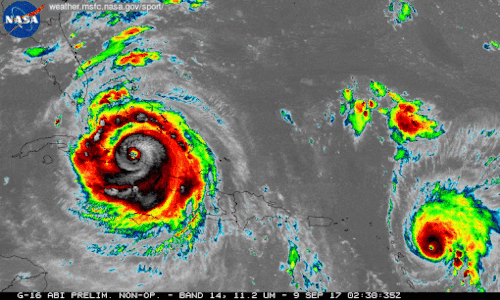
We're using our unique vantage point in space to provide observations and data of Hurricane Irma and other tropical storms. Hurricanes Irma and Jose are seen here in a 12-hour long infrared loop. Scientists monitor storms in infrared to closely monitor clouds and storm intensity. We continue to provide satellite imagery for these storms, tracking its trajectory, force and precipitation to inform forecasters at the National Hurricane Center.
As these storms continue their westward drive in the coming days, they will be passing over waters that are warmer than 30 degrees Celsius (86 degrees Fahrenheit)—hot enough to sustain a category 5 storm. Warm oceans, along with low wind shear, are two key ingredients that fuel and sustain hurricanes. Get the latest imagery and data from us at www.nasa.gov/hurricane For information on making preparations for Hurricanes, visit the FEMA website at: ready.gov/hurricanes. Credit: NASA-SPoRT/NOAA
Make sure to follow us on Tumblr for your regular dose of space: http://nasa.tumblr.com.
Splish, Splash, Orion Takes a Bath
The Orion spacecraft is a capsule built to take humans farther than they’ve ever gone before, to deep space and eventually Mars. But before astronauts travel inside this new vehicle, we have to perform tests to ensure their safety.

One of these tests that we’ll talk about today simulates an ocean splashdown. Water impact testing helps us evaluate how Orion may behave when landing under its parachutes in different wind conditions and wave heights. The spacecraft has been undergoing a series of these tests at our Langley Research Center’s Hydro Impact Basin…which is our fancy way of saying pool.

The test capsule, coupled with the heat shield from Orion’s first spaceflight, swung like a pendulum into Langley’s 20-foot-deep basin on Aug. 25.

Inside the capsule were two test dummies – one representing a 105-pound woman and the other, a 220-pound man — each wearing spacesuits equipped with sensors. These sensors will provide critical data that will help us understand the forces crew members could experience when they splash down in the ocean.
This specific drop was the ninth in a series of 10 tests taking place at Langley’s Landing and Impact Research Facility. It was designed to simulate one of the Orion spacecraft’s most stressful landing scenarios, a case where one of the capsule’s three main parachutes fails to deploy. That would cause Orion to approach its planned water landing faster than normal and at an undesirable angle.
Under ideal conditions, the Orion capsule would slice into the water of the Pacific Ocean traveling about 17 miles per hour. This test had it hitting the pool at about 20 mph, and in a lateral orientation. Instead of being pushed down into their seats, astronauts in this scenario would splashdown to the side.
With this test’s success and one final drop in this series scheduled for mid-September, researchers have accumulated a lot of important information.
To find out more, visit nasa.gov or follow @nasaorion on Tumblr, Twitter and Facebook.
Make sure to follow us on Tumblr for your regular dose of space: http://nasa.tumblr.com
7 Sports Astronauts Love Without Gravity (Including Football)
Astronauts onboard the International Space Station spend most of their time doing science, exercising and maintaining the station. But they still have time to shoot hoops and toss around a football.
From chess to soccer, there’s a zero-gravity spin to everything.
1. Baseball



Baseball: America’s favorite pastime. JAXA astronaut, Satoshi Furukawa shows us how microgravity makes it possible to be a one-man team. It would be a lot harder to hit home runs if the players could jump that high to catch the ball.
2. Chess
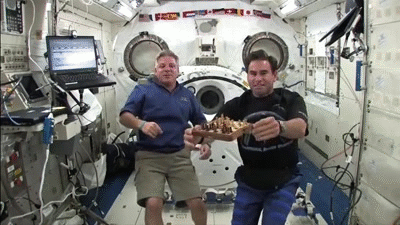
Yes, it’s a sport, and one time NASA astronaut Greg Chamitoff (right) played Earth on a Velcro chess board. An elementary school chess team would pick moves that everyone could vote for online. The winning move would be Earth’s play, and then Chamitoff would respond. About every two days, a move would be made. But who won the historic Earth vs. Space match? Earth! Chamitoff resigned after Earth turned its pawn into a queen, but it was game well played.
3. Soccer

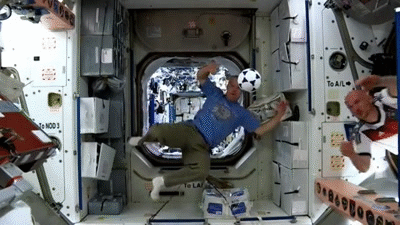
NASA astronaut Steve Swanson put a new spin on soccer by juggling the ball upside down. However, he might not have considered himself upside down. On the space station, up and down are relative.
4. Gymnastics
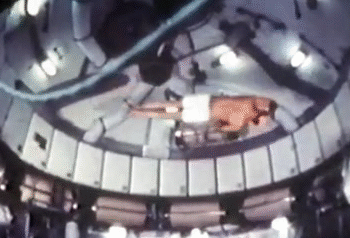
NASA astronauts usually sign off their videos with a zero-gravity somersault (either forwards or backwards). But astronauts are also proficient in handstands, flips and twists. The predecessor to the International Space Station, the Skylab, had the best space for the moves. The current space station is a bit tight in comparison.
5. Basketball

Objects that aren’t heavy don’t move very well on the space station. They kind of just float. It’s like Earth, but exaggerated. For example, on Earth a beach ball wouldn’t go as far as a basketball. The same is true in space, which is why playing with a basketball in space is more fun than playing with a beach ball.
6. Golf

People talk about hitting golf balls off skyscrapers, but what about off the International Space Station? While golf isn’t a normal occurrence on the station, it’s been there. One golf company even sent an experiment to the station to find out how to make better golf clubs.
7. Football

Zero gravity doesn’t make everything easier. Astronauts need to relearn how to throw things because their brains need to relearn how to interpret sensory information. A bowling ball on the space station no longer feels as heavy as a bowling ball on Earth. When astronauts first throw things on the space station, everything keeps going too high. That would put a wrench in your spiral for a couple of months. But once you adjust, the perfect spiral will just keep spiraling!
Make sure to follow us on Tumblr for your regular dose of space: http://nasa.tumblr.com
Black (Hole) Friday!
It’s Black Friday, but for us, it’s the annual Black Hole Friday! Today, we’ll post awesome images and information about black holes.

A black hole is a place in space where gravity pulls so much that even light cannot get out. The gravity is so strong because matter has been squeezed into a tiny space…sort of like all of those shoppers trying to fit into the department stores today.

Because no light can get out, you can’t see black holes with the naked eye. Space telescopes with special tools help find black holes (similar to how those websites help you discover shopping deals).

How big are black holes? Black holes can be large or small…just like the lines in all of the stores today. Scientists think the smallest black holes are as small as just one atom. These black holes are very tiny but have the mass of a large mountain!

So how do black holes form? Scientists think the smallest black holes formed when the universe began. Stellar black holes are made when the center of a very big star collapses. When this happens, it causes a supernova.

A supernova is an exploding star that blasts part of its mass into space.

Supermassive black holes are an altogether different story. Scientists think they were made at the same time as the galaxy they in they reside. Supermassive black holes, with their immense gravitational pull, are notoriously good at clearing out their immediate surroundings by eating nearby objects.

When a star passes within a certain distance of a black hole, the stellar material gets stretched and compressed -- or "spaghettified" -- as the black hole swallows it. A black hole destroying a star, an event astronomers call "stellar tidal disruption," releases an enormous amount of energy, brightening the surroundings in an event called a flare. In recent years, a few dozen such flares have been discovered.

Then there are ultramassive black holes, which are found in galaxies at the centers of massive galaxy clusters containing huge amounts of hot gas.

Get more fun facts and information about black holes.
Follow us on social media.
Make sure to follow us on Tumblr for your regular dose of space: http://nasa.tumblr.com

Hello there 👋
Welcome to Mindful Monday. It’s good to see you 🧘
For our second week, we’ve got an offer of mindfulness y’all can’t POSSIBLY refuse: join us as we tour the rings of Saturn with NASA! Turn on, tune in, and space out to relaxing music and stunning ultra-high-definition visuals of our cosmic neighborhood 🌌
Sounds good, right? Of course, it does. You can watch even more Space Out episodes on NASA+, a new, no-cost, ad-free streaming service.
Why not give it a try? Just a few minutes this Monday morning can make all the difference to your entire week, as @nasa helps to bring mindfulness from the stars and straight to you.
🧘WATCH: Space Out with NASA: Rings of Saturn 12/04 at 1pm EST🧘

Ever want to ask a real life astronaut a question? Here’s your chance!
Astronaut Jeanette Epps will be taking your questions in an Answer Time session on Friday, May 5 from 10am - 11am ET here on NASA’s Tumblr. See the questions she’s answered by visiting nasa.tumblr.com/tagged/answertime!
NASA astronaut Jeanette J. Epps (Ph.D.) was selected as an astronaut in 2009. She has been assigned to her first spaceflight, which is scheduled to launch in May 2018. Her training included scientific and technical briefings, intensive instruction in International Space Station systems, spacewalk training, robotics, T‐38 flight training and wilderness survival training.
Before becoming an astronaut, Epps worked as a Technical Intelligence Officer at the Central Intelligence Agency (CIA).
Born in Syracuse, New York. Enjoys traveling, reading, running, mentoring, scuba diving and family.
She has a Bachelor of Science in Physics from LeMoyne College, as well as a Master of Science and Doctorate of Philosophy in Aerospace Engineering from the University of Maryland.
Follow Jeanette on Twitter at @Astro_Jeanette and follow NASA on Tumblr for your regular dose of space.
-
 lunamazes reblogged this · 10 months ago
lunamazes reblogged this · 10 months ago -
 lunamazes liked this · 10 months ago
lunamazes liked this · 10 months ago -
 learnheadvassbidcooks liked this · 1 year ago
learnheadvassbidcooks liked this · 1 year ago -
 itsjustalittlevampire reblogged this · 2 years ago
itsjustalittlevampire reblogged this · 2 years ago -
 stardating reblogged this · 3 years ago
stardating reblogged this · 3 years ago -
 maryjaneyoudrivemeinsane reblogged this · 3 years ago
maryjaneyoudrivemeinsane reblogged this · 3 years ago -
 chilled-manu liked this · 3 years ago
chilled-manu liked this · 3 years ago -
 fayelafaye liked this · 4 years ago
fayelafaye liked this · 4 years ago -
 fastofthekillones liked this · 4 years ago
fastofthekillones liked this · 4 years ago -
 annoyinglyeclecticruins reblogged this · 4 years ago
annoyinglyeclecticruins reblogged this · 4 years ago -
 annoyinglyeclecticruins liked this · 4 years ago
annoyinglyeclecticruins liked this · 4 years ago -
 lbittersweet liked this · 4 years ago
lbittersweet liked this · 4 years ago -
 promptgpt liked this · 4 years ago
promptgpt liked this · 4 years ago -
 withkneesafringed reblogged this · 4 years ago
withkneesafringed reblogged this · 4 years ago -
 dia0301 liked this · 4 years ago
dia0301 liked this · 4 years ago -
 autisticaceboy liked this · 4 years ago
autisticaceboy liked this · 4 years ago -
 diamondkeeling liked this · 4 years ago
diamondkeeling liked this · 4 years ago -
 bezkraen reblogged this · 4 years ago
bezkraen reblogged this · 4 years ago -
 corv1kn1ght liked this · 4 years ago
corv1kn1ght liked this · 4 years ago -
 reallywannafly liked this · 4 years ago
reallywannafly liked this · 4 years ago -
 grrrlgerms liked this · 4 years ago
grrrlgerms liked this · 4 years ago -
 flippingmyfins liked this · 4 years ago
flippingmyfins liked this · 4 years ago -
 lamaplant liked this · 4 years ago
lamaplant liked this · 4 years ago -
 vosquitransitis liked this · 4 years ago
vosquitransitis liked this · 4 years ago -
 babblefishgirl liked this · 4 years ago
babblefishgirl liked this · 4 years ago -
 renjunniesmoomin liked this · 4 years ago
renjunniesmoomin liked this · 4 years ago -
 violetablood liked this · 4 years ago
violetablood liked this · 4 years ago
Explore the universe and discover our home planet with the official NASA Tumblr account
1K posts